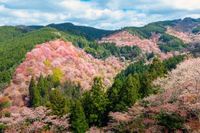As spring approaches, the cherry blossoms in Toyama Prefecture are beginning to bloom, signaling the arrival of warmer weather. On March 26, 2025, the weather in Toyama was mostly sunny, with the temperature peaking at 23 degrees Celsius in Toyama City and 22.3 degrees in Takaoka City Imaki. During the day, temperatures fluctuated around 15 degrees Celsius, making it feel a bit chilly for residents and visitors alike.
However, the forecast for March 27 predicts a significant rise in temperatures, with Toyama City expected to reach 28 degrees and Takaoka City Imaki 27 degrees, resembling early July warmth. This increase in temperature is a welcome change as the buds of the iconic Somei-yoshino cherry trees are swelling and turning a vibrant pink, ready to burst into bloom.
The Matsukawa River area, known for its cherry blossoms, has fully opened its walking path to coincide with the cherry blossom season, allowing people to enjoy the stunning views of the blooming trees. This year, the cherry blossoms are particularly anticipated, as they are a symbol of spring in Japan, drawing locals and tourists alike to admire their beauty.
Interestingly, the Somei-yoshino cherry trees, which are prevalent throughout Japan, are all genetically identical clones. This phenomenon, known as cloning, means that all the trees bloom simultaneously, creating a breathtaking display of flowers. This unique trait is due to the fact that Somei-yoshino trees cannot fertilize themselves; they are propagated through grafting onto other trees, typically Yama-zakura.
The Somei-yoshino (Cerasus × yedoensis 'Somei-yoshino') is believed to be a hybrid of Oshima-zakura and Edo-higan, resulting from either natural or artificial crossbreeding. The history of these trees is deeply intertwined with Japan's cultural heritage, particularly in regions like Yoshino in Nara Prefecture, which is renowned for its cherry blossom viewing.
Yoshino has long been a celebrated cherry blossom viewing spot, with its history dating back to the cherry blossom viewing event held by Toyotomi Hideyoshi in 1594. This event popularized the tradition of hanami, or flower viewing, among the Japanese people. The Todo family played a significant role in the movement of Yama-zakura cherry trees from Yamato Province to Edo (modern-day Tokyo), further expanding the cherry blossom culture across the country.
During the Tokugawa Yoshimune era, cherry blossom viewing was actively encouraged as a means of providing recreation for the common people. This led to the planting of numerous cherry trees in urban areas, such as along the Sumida River and at Asukayama, enhancing the beauty of these locations during the spring season.
One notable family in the history of cherry tree cultivation is the Ito Ihei family, who ran a nursery in the area of present-day Komagome and Sugamo in Toshima, Tokyo. They are credited with improving cherry tree varieties, including the development of the Somei-yoshino, which has become synonymous with cherry blossom viewing in Japan.
Mount Yoshino is home to approximately 30,000 cherry trees, predominantly the Shiro-yama-zakura variety, which produces pinkish-white flowers. This diversity in cherry tree species contributes to the unique beauty of the landscape, especially as the trees bloom at different times, creating a more dynamic and colorful display than the uniformity of the Somei-yoshino trees.
In 2004, Mount Yoshino was designated as a UNESCO World Heritage Site as part of the 'Sacred Sites and Pilgrimage Routes in the Kii Mountain Range,' recognizing its cultural and historical significance. Visitors to the area can explore landmarks such as the Kinpusen-ji Temple, which houses the National Treasure Zao-do, and the Yomodono-zakura tree, where Prince Morinaga held his last banquet before the fall of Yoshino Castle.
Yoshimizu Shrine, another important site, served as Hideyoshi's cherry blossom viewing headquarters, and from here, visitors can enjoy panoramic views of the cherry trees, including the famous 'Ichimoku Senbon' viewpoint, which offers a breathtaking sight of the blooming cherry blossoms.
The contrast between the Somei-yoshino's uniformity and the diverse range of cherry trees in Yoshino highlights the complexity of Japan's relationship with nature. While the Somei-yoshino's mass blooming creates an impressive spectacle, the variety found in Yoshino offers a more natural and profound beauty, showcasing the rich tapestry of Japan's floral heritage.
As the cherry blossoms begin to bloom in Toyama and across Japan, it serves as a reminder of the beauty of nature and the cultural traditions that have evolved around these iconic trees. The cherry blossom season is not just about the flowers; it's a celebration of life, renewal, and the deep connections between the Japanese people and their environment.
In reflecting on the origins and cultivation of the Somei-yoshino, one cannot help but consider how human intervention has shaped the landscapes we now cherish. The cherry blossoms, both in Toyama and in Yoshino, invite us to appreciate the delicate balance between nature and humanity, urging us to think about our role in preserving these natural wonders for future generations.




